Newsstand & Direct Edition Data - Where GPAnalysis is leading the way
Before the introduction of the direct market in the late-1970s, every comic book was a newsstand edition. Comics published from the 1930s to the late-1970s were all newsstand editions, which meant three things: 1) They could be returned for credit if they didn’t sell by a certain date, 2) They were not ordered according to demand, but according to distributor processes, and 3) both serious and casual comic collectors obtained copies of identical comic books, since all books were newsstand editions.
The traditional book store and comic book specialty shops existed before the direct market. Serious collectors may have preferred to make comic book purchases as comic book specialty shops, but they were purchasing the same edition of comic book that was available from a newsstand vendor, grocery store, or any other location that comic books were sold.
With the introduction of the direct market, comic book publishers were able to supply comic shops with exactly the number of copies of each book that the retailer purchased. Additionally, in exchange for a discount on the price of each comic book, the direct edition books could not be returned for credit. Comic shop owners could decide which books would sell best, which books would be good to keep in the back issue inventory, and which books were lower priority or not sold at all in their stores.
For the most part, CGC has not identified any differences in the number of direct editions and the number of newsstand editions graded by CGC. Except for cases where the two editions have different printed cover prices, there are few cases where a review of the CGC Census alone will provide newsstand and direct edition data. GPAnalysis.com has identified differences in direct edition and newsstand CGC graded comic sales for a few years for particular comics where the market has demonstrated a difference in pricing averages. Not every comic is identified by GPAnalysis as direct or newsstand edition, but a few of the more popular CGC submissions and sales have been identified.
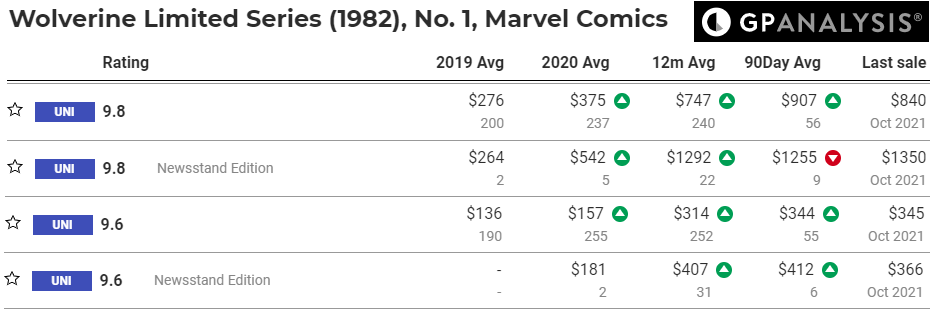
The twelve-month average on GPAnalysis shows 240 direct edition CGC 9.8 and 22 newsstand edition CGC 9.8 sales for Wolverine Limited Series #1 (1982), for an 8.4% newsstand percentage in CGC 9.8. In the past 90 days, the CGC 9.8 newsstand percentage has been 13.8%, and during 2020, the CGC 9.8 newsstand percentage was 2.1%. The twelve-month average of 8.4% can be used as an estimate for the percentage of CGC 9.8 newsstand editions on the CGC Census, where Wolverine Limited Series #1 has just over 4,000 CGC 9.8 copies graded. Each CGC grade can be evaluated in this method, using the GPAnalysis 12m Avg (number of recorded sales) for direct editions and newsstand editions for Wolverine Limited Series #1. The resulting estimates for the CGC graded counts for each edition are charted below.
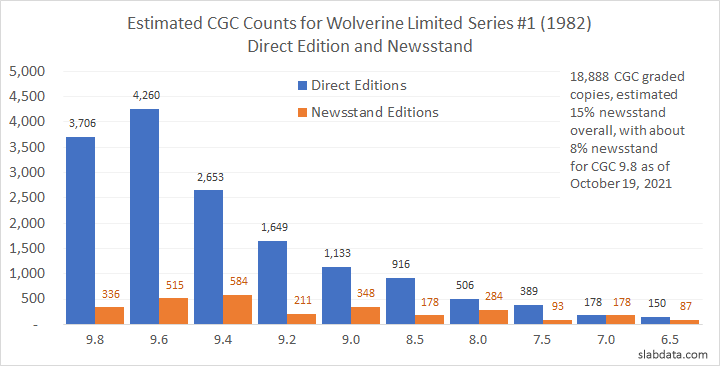
Despite the fact that the direct market was still very young in 1982, the majority of surviving high grade copies of Wolverine Limited Series #1 are direct editions, with fewer than 10% of the CGC 9.8 copies estimated as being from newsstand editions. There appear to be about 85% direct editions and 15% newsstand books overall in “CGC worthy” conditions submitted and graded by CGC, according to estimates from the many recent sales in the market recorded. GPAnalysis separates the newsstand and direct edition sales recorded for this comic, even though CGC does not make any distinction in the CGC Census or on the CGC label of the encapsulated books. The same process of determining the percentage of recorded sales for direct editions and newsstand editions can be applied for any books separated by GPAnalysis.
Unlike Wolverine Limited Series #1, the immediate popularity and demand for Amazing Spider-Man #361 (1992) seems to have been underestimated by comic shop owners. Comic shop customers who didn’t get enough copies of Amazing Spider-Man #361 direct editions from their comic shops seem to have purchased many of the newsstand editions of Amazing Spider-Man #361. Those particular newsstand books for Amazing Spider-Man #361 were likely added into primarily direct edition collections, and those collectors would have protected that particular newsstand issue as well as they protected their other direct edition books. The percentage of surviving high grade copies of Amazing Spider-Man #361 newsstand editions are significantly higher than the 8% rate associated with Wolverine Limited Series #1, ten years earlier. An estimate of nearly 30% of CGC 9.8 graded copies of Amazing Spider-Man #1 are newsstand editions.
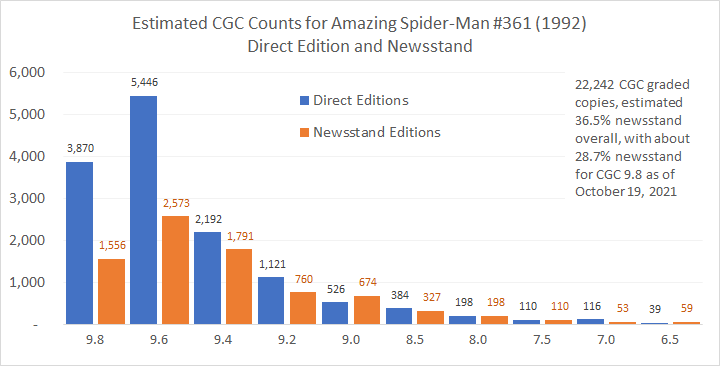
It is likely that those high grade newsstand books (over 28% for CGC 9.8) have spent the past three decades well-protected in the collections of primarily direct edition collectors who picked them up from newsstand vendors in 1992, as a result of comic shop direct editions being unavailable (sold out).
Because GPAnalysis.com is currently compiling the CGC graded sales for both direct editions and newsstand books, these new estimates that are possible for percentages of newsstand and direct edition on the CGC Census are exciting but still just estimates. It’s impossible to know exactly how many of each edition of book were printed, and it’s more impossible (if more impossible were possible) to know how many survived the decades and in which grades. Estimates are all that will ever be possible, and additional information should refine these estimates whenever data drives those changes.
The direct market grew from non-existent in the mid-1970s to the only market by the year 2014 (for Marvel) and by 2018 (for D.C. Comics). An increase in the percentage of direct edition books would be expected to follow that general trend of “fewer direct editions” in the early 1980s when compared to “more direct editions” by the year 2010. However, this general trend is not a perfect match to the available data, and the percentage of direct editions varies by the CGC grade as well.
Between Wolverine Limited Series #1 in 1982 and Amazing Spider-Man #361 in 1992, Amazing Spider-Man #300 from 1988 is the most submitted book to CGC. The percentage of CGC 9.8 Amazing Spider-Man #300 is only about 2%, according to GPAnalysis sales records. This percentage is lower than both Wolverine Limited Series #1 from 1982 and Amazing Spider-Man #361 in 1992, indicating that there may be a general trend toward more direct editions as time progresses, but each comic book may have a different story to tell when it comes to newsstand percentages at each grade.

While these two editions of Amazing Spider-Man #300 have identical contents, and nearly identical covers (differing only by the newsstand UPC barcode on the front), the percentages of CGC grades for recorded sales on GPAnalysis.com appear completely separate.
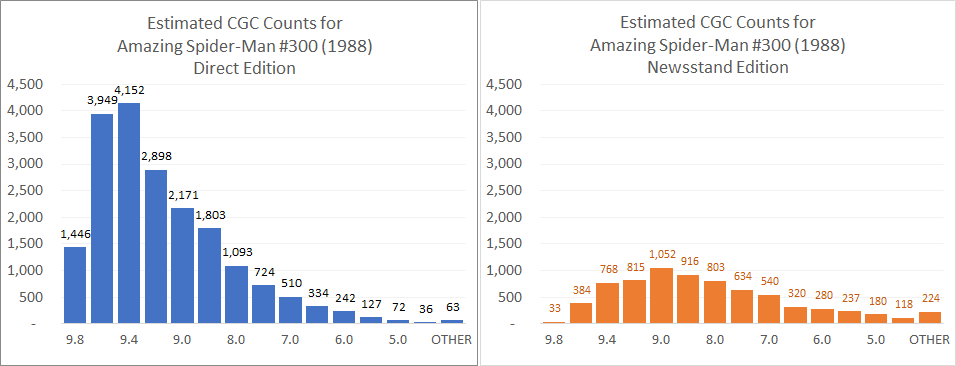
A striking observation about the estimates for Amazing Spider-Man #300 is that the newsstand editions bear a CGC grade distribution which looks more like a mid-1970s comic than the direct editions of the same issue. Compare the Amazing Spider-Man #300 newsstand edition estimated distribution to the actual CGC Census counts for Incredible Hulk #180 (1974), before the start of the direct market.
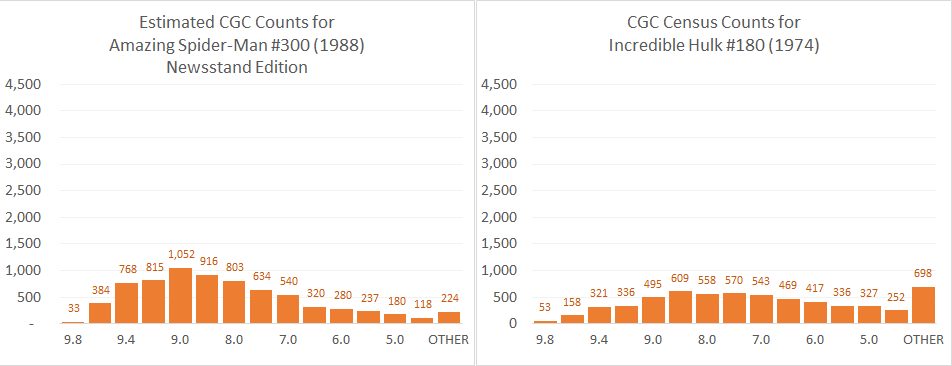
One explanation would be that direct edition comic books satisfied the most “serious” of the collectors of the day, being purchased at comic shops which offered protective bags and boards by professional comic book retailers who took more care with the condition than a newsstand vendor (or newsstand customers) might have done. There were, of course, newsstand customers who protected their comics well and there were comic shop customers who did not protect their comics at all, but in general, 1980s comic shops were frequented by “serious” comic collectors and 1980s newsstand vendors were not.
In the most general (and the most applicable) scenarios, direct editions and newsstand editions were available from two different types of retailers, purchased by two different types of collectors, and the decades that followed reflected the protective care (or lack) generally provided in two different environments. Newsstand and direct editions of identical comics are essentially twins separated at birth and raised apart, as evidenced by the Amazing Spider-Man #300 direct edition and newsstand edition charts shown above.
In addition to the comic books examined thus far, New Mutants #98, Spawn #1, and Spawn #9 have also been estimated by the same process. In each case, the estimates for CGC 9.8 percentages of newsstands are the lowest, with surviving percentage estimates for lower grades, CGC 9.6, CGC 9.4, etc., increasingly becoming more common when compared to direct edition estimates.
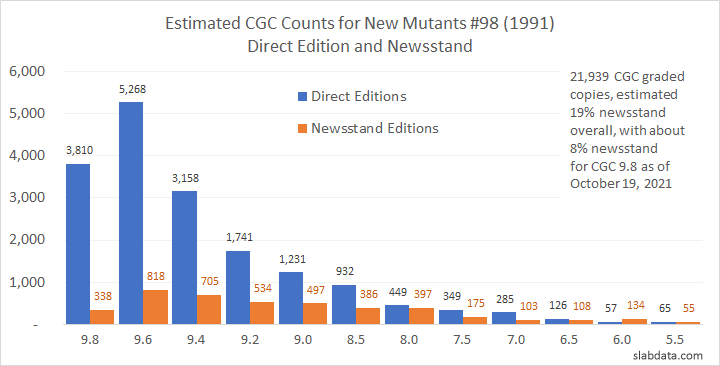
New Mutants #98 (1991) displays roughly the same percentages for newsstand editions as Wolverine Limited Series #1, nine years earlier. Perhaps little had changed in the comic collecting community between 1982 and 1991, related to the popularity of “mutants” in the Marvel line of comics, the ordering patterns of comic shop owners, the protection methods of comic collectors, and the general environments those books have survived prior to being CGC graded. An alternative scenario is that many things had changed between 1982 and 1991, but those differences which would impact the survival rates and volumes of books submitted to CGC simply cancel each other out. Whatever the reasons, the current CGC Census and GPAnalysis percentages for direct and newsstand editions of Wolverine Limited Series #1 and New Mutants #98 are nearly identical.

One observation about the frequency of newsstand editions being submitted to CGC is that the GPAnalysis recorded sales averages are a factor in submission rates. While it is true that comic books with lower values are submitted less often than other comics of the same age, it is also true that direct editions may be submitted less often than newsstand editions for the same comic. In the case of Spawn #1 (1992), the GPAnalysis sales average for CGC 9.0 direct editions is $72 while the sales average for CGC 9.0 newsstand editions is $154. As a result, collectors may choose not to submit Spawn #1 direct editions at the same rate as newsstands for books in the 9.0 range. The cost of CGC submission may be prohibitive for 9.0 direct editions, but profitable for 9.0 newsstand editions.

Spawn #9 is particularly interesting because CGC did begin to note newsstand editions separately in the CGC Census during 2013. The actual CGC Census for Spawn #9 newsstand is lower than the CGC estimates possible from the most recent twelve months of GPAnalysis.com recorded sales. It is likely that interest in newsstand books is still increasing, along with increasing knowledge of these differences, and the CGC market is showing more activity for newsstand books recently. In the prior twelve months, 12% of CGC market sales for Spawn #9 have been newsstand while only 8% of the CGC Census for Spawn #9 is newsstand.
Much like Spawn #1, it would be reasonable to assume that many direct edition copies of Spawn #9 are not yet “CGC worthy” in terms of their resale value and remain ungraded. On the other hand, CGC 9.4 Spawn #9 newsstand editions have average sales of $150, making the Spawn #9 newsstands far more likely to be submitted to CGC than direct editions at CGC 9.4 (and under) grades. It would be expected that the number of CGC 9.4 direct editions on the CGC Census would be much higher if (or when) the average sale prices for CGC 9.4 direct edition Spawn #9 become significantly higher than $54.
As time progresses, the available information about the differences and estimates for newsstand and direct editions of the same book may become clearer, but there are already thousands of recorded sales on GPAnalysis.com where the direct edition and newsstand indications have been recorded. Those thousands of recorded sales are now providing data-driven insight where only guesses were possible before, thanks to GPAnalysis leading the way.
About the Author
 |
Greg Holland has collected comic books for over 30 years and has been the administrator of the CGC Census Analysis website since 2003, currently located at CGCdata.com. He is the 1999 founder of the ValiantComics.com website and the 2004 ValiantFans.com message board. Dr. Holland holds a Ph.D. in information quality from the University of Arkansas at Little Rock and has held data science positions as research director, analyst, and administrator for government, corporations, and university. Active on the CGC Forums as ‘valiantman’ since 2002, he is also a 15+ year advisor to the Overstreet Comic Book Price Guide and contributor to later editions of the Standard Catalog of Comic Books. Greg resides in Arkansas, USA, with his wife and their daughter. |
Related news
24 Oct 2022
Canadian Price Variants (CPVs) and GPAnalysis.com Recorded Sales
With Canadian Price Variants recorded in GPAnalysis.com for decades, what can the data tell us about rarity and value when comparing against direct editions?
Read more26 May 2022
CGC Census - A Game for the Thousandth Collector
Imagine a game where 1,000 lucky comic collectors are awarded the best available copies of comic books from the CGC Census. Where would ticket #1,000 be for the earliest appearances of favorite characters? Some winning books may surprise you.
Read more